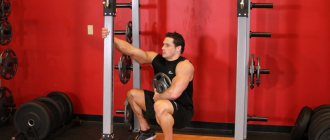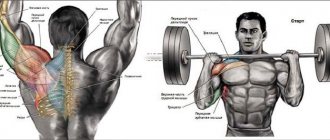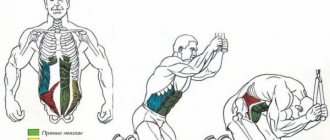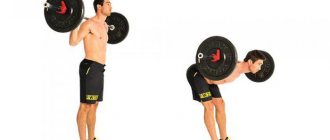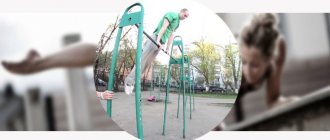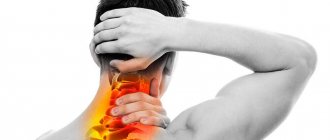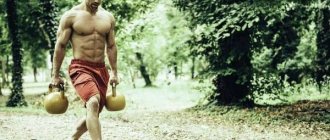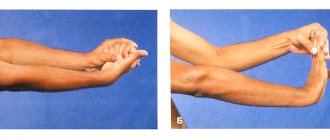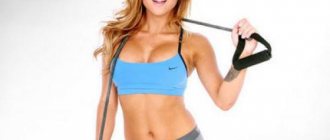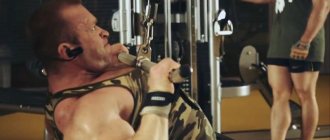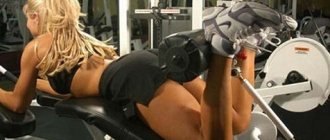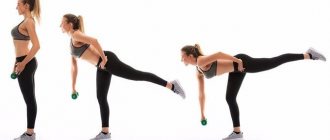Arnold Schwarzenegger's "donkey" exercise is a strength exercise that is aimed at building the muscles of the lower leg. Essentially, it involves performing bent-over calf raises. It received its comic name due to the association with the animal of the same name during its execution.
The exercise became popular thanks to the famous bodybuilder Arnold Schwarzenegger. Not distinguished by outstanding calves, the future “Mr. Olympia” often performed the “donkey” exercise with two partners on his back in order to quickly level out his genetic “lag.”
Arnold performed the exercise with a maximum range of motion, fully stretching the calf muscles at the bottom and moving all the way up until there was a strong burning sensation. This allowed us to achieve maximum efficiency.
In this article, you will learn the basic information that will help you achieve perfect calves.
Features of the exercise
The donkey exercise is aimed at creating volume and thickness in the calves. Its main feature is the absence of a compressive load on the spine, as a result of which it is used, among other things, by athletes with back injuries.
The main load is received by the triceps muscles of the leg, combining the lateral and medial heads, as well as the soleus muscle. During the exercise, the tibialis anterior muscle is partially involved.
Benefits of Exercise
Working all the muscles of the lower leg
When performing this exercise, both the gastrocnemius and soleus muscles are simultaneously used. For those who don’t know, I’ll explain now. The calves are made up of several muscles (and both muscles are extremely important).
The biceps gastrocnemius muscle is located on the back of the lower leg and forms the top of the calf. Why two-headed? Because it consists of two heads - medial and lateral, with a low percentage of body fat they are clearly visible. The soleus muscle is slightly wider than the gastrocnemius, and is located directly below it, it kind of pushes the CALF OUT (due to this it looks more massive).
This is why both the CALVES and the SOLEUS MUSCLE are extremely important. It is absolutely impossible to develop one thing while neglecting the other. It's simple: CALVES without soleus will not look as massive (large) as they could look, and vice versa. The donkey exercise comes in handy in this regard (because it develops both at the same time).
No excessive stress on the spine
The donkey exercise relieves excessive stress on the spine. For example, if you compare this exercise with “standing up on your toes in a machine or with a barbell on your shoulders.”
Do you understand? This is heaven and earth, I'm serious... when you stand vertically, with a load (for example, a barbell) on the trapezius, a strong vertical load is created on your spine, and in the donkey there is no such thing, because. there you stand not vertically, but in an inclined position, that is, your torso is tilted forward. Because of this, the load on the spine is not so breaking (strong). This nuance is especially relevant for those who have any problems with the spine.
Better Calf Stretch
In the donkey exercise, due to the peculiarity of the execution, namely the fact that the torso is tilted forward, a much more effective (better) stretching of the calf muscles is created, in comparison with the same exercise - raising on the toes while standing, therefore, a better contraction (working) of the muscles occurs .
In general, as you can see, the exercise has a lot of advantages, however, as I said earlier, the vast majority of people have never done it and probably won’t do it because... afraid to look ridiculous, etc. But you’re not one of those people, right?
Execution technique
Let's consider the technique of performing the “donkey” exercise:
- To perform this exercise, you need a bent over calf raise machine. Lean forward and rest your lower back on the exercise pad.
- Place your hands on the handles, stand on the stand, transferring your body weight to your toes. Lower your heels and point your toes in the right direction depending on which area you want to work. Straighten your legs but keep your knees slightly bent. This is the starting position.
- As you exhale, rise onto your toes as high as possible. During the movement, the knees should remain motionless, only the calves are included in the work. Pause for a second at the top.
- As you inhale, slowly lower yourself to the starting position.
Leg position options
The exercise, depending on the placement of the feet, allows you to “point” influence different parts of the calf muscles:
- If you spread your socks apart, the load will fall on the inner bands of your calves.
- If you bring it inward, then the accentuated effect will be on the outer bundles of the calf muscles.
For beginners, we recommend mastering the exercise with parallel feet. This technique evenly distributes tension across the lower leg muscles and helps strengthen the tendons.
After the athlete learns to perform the “donkey” with parallel feet, you can try other options for placing the legs.
Execution options
Let's consider the main options for performing the exercise:
- Donkey exercise with a partner or weights on your back. This option is perfect for those athletes who do not have a target machine in the gym. In this case, the “weight” will be a partner sitting on the athlete’s hips. You can also use a weight, placing it below the base of your lower back.
- Donkey exercise without weight. If you are in the initial stages of training, you need to work out the execution technique. In this case, the exercise option without using additional weights is suitable for you.
Exercise "Donkey"
The calf muscles, which are part of the lower leg, are considered the most resilient part of the human body. Due to the fact that the calf is constantly working, pumping it becomes more difficult than other parts of the body. Since the calf muscle develops tolerance to physical activity, exercises have to be developed that are special and unusual for this part of the body.
The “Donkey” exercise for the legs is the kind of training that can be a shock to the calf and move it in a different way. This training was very popular with Arnold Schwarzenegger, who, as you know, suffered from very weak calf muscles and considered them his weakest side. At one time there was even a case where the career of a bodybuilder and actor could have suffered because of this part of the body.
Possessing the title of Mr. Olympia depended entirely on whether he could cope with this shortcoming. At this moment the Donkey exercise came to the rescue. This training received this name due to the fact that its implementation is similar to this animal.
Calf muscle training
Execution technique
- You need to put some kind of elevation on the floor and stand on it; it is also very important to find a support point, this could be a frame that is tilted.
- Place your toes in an elevated position. Bend forward and lean on the selected support (table, frame, chair). The hip joint in this position should be at the level of the toes.
- Have someone sit on your back. At home, these could be family members, at the gym: a coach, a friend, or just a stranger working out with you in the same room. Such weights must be placed on the legs, and not on the lower back, this is very important.
- Point your heels down and feel all the muscles in your legs stretch. Then do a calf raise to the maximum point where the contraction occurs. Stay at the high point for a few seconds.
- The number of repetitions depends on the physical capabilities of the trainee.
Exercise Donkey video
What muscles work or what trains?
triceps muscle
- The gastrocnemius is a biceps muscle that runs from the thigh bone toward the foot, where it attaches to the Achilles tendon. These muscles are the most important ones, which create the visual appearance of the lower leg and its bulk.
- The soleus is a large and flat muscle that extends from the tibia and extends toward the foot, attaching to the Achilles tendon. It extends under the calf and is smaller in size than it. This muscle is important for the aesthetic appearance of the lower leg and plays a significant role in its development.
- Plantar. It is a small muscle with a long tendon. It starts from the hip line and is located between the gastrocnemius and soleus. The most interesting thing is that ten percent do not have it.
- Anterior tibial. It originates from the tibia. Its main function is to supinate and extend the foot.
The lower leg and its muscles perform the following work:
- It is involved in the flexion of the ankle and foot;
- Helps with inward rotation;
- Supination and extension of the foot.
Experts call the best training in bodybuilding for the development of lower leg muscles:
- Exercise Donkey
- Exercise on toes in the simulator
- Training on toes while standing in the simulator
- Toe press
These trainings answer the question of what can be replaced.
Nuances
Doing the exercise with a partner
When doing this, you should know some nuances:
- It is very important to maintain proper breathing. When inhaling, make a downward movement, and when exhaling, make an upward movement.
- The toes can be placed in different positions, for example, these can be the following positions: inward, straight, outward. The position of the socks determines which area should be worked.
- Your knees should be slightly bent and you should not squeeze or straighten them too much.
- It is also worth knowing that the knees should remain motionless throughout the entire training.
- Try to rise to the maximum point, the higher the better.
- Orient the weight of the assistant, who is on the back of the trainee, for three sets, repetitions should be about twenty, maybe a little less.
- If you place your feet in different positions, the load will go to different parts of the lower leg.
- This exercise is also relevant for the fairer sex.
- In this exercise, girls can call for helpers: a friend, sister, mother or child. Male weight will be relevant for more trained ladies.
Conclusion
By developing your calves, you bring your whole body into harmony and make your legs stronger and more resilient. And resilient and strong legs are the key to the fact that a person will be able to lead an active lifestyle for a long time, regardless of age and gender.
Get better and stronger with bodytrain.ru
Read other articles in the blog's knowledge base.
Related posts:
Australian pull-ups
What muscle groups are worked on an elliptical trainer?
Concentrated biceps curl
Raider Row Source: bodytrain.ru
This is interesting: Lunges in the Smith machine: formative exercise for the legs, technique and rules for performing lunges in the Smith machine
Adviсe
Below are some tips to help you with the donkey exercise.
- If you do not have a specialized exercise machine nearby, then ask your partner to play the role of a weight, sitting on your back. Also, a hack machine can act as a full replacement for a special stand.
- When performing the exercise with a partner, make sure that their weight is on the pelvic area and not the lower back. It is also important that the partner assumes a static position.
- When performing the exercise with a partner, be sure to use a pad under the toe to increase the amplitude.
- To significantly load the calf muscles, perform a 1-2 second peak contraction at the top of the range of motion.
- For a complete workout, periodically change the position of your legs: a parallel position allows you to distribute the load evenly between both heads of the biceps surae muscle; the outer direction of the toe transfers the load to the medial bundles; connecting the toes increases the share of participation in the work of the lateral part of the muscles.
- Do not allow the sock to slip off the support. This can cause damage to ligaments and tendons.
- Girls can perform the “donkey kicks to the left” exercise, alternating it with the classic version of this exercise, which will allow you to pump up both the gluteal and calf muscles in one workout. From the starting position, standing on all fours, you need to stretch your left leg to the side, turning your knee up as much as possible, and then return to the starting position. The “donkey kicks to the right” exercise is performed by analogy, the only difference is in the working leg.
General recommendations and advice
To increase the effectiveness of the exercise:
- alternate the training rhythm, changing high-repetition and low-repetition training, taking breaks of one or two minutes between approaches;
- do powerful lifts, hold the accepted position of your calves in the top position, lower yourself slowly, thereby achieving maximum contraction;
- spread your socks to the sides to transfer the main load to the inner part of the calf muscles, bring them together to achieve the opposite effect - concentration on the outer part. This way you will tighten lagging muscles.
Place in the training program
It is recommended to perform the donkey exercise at the end of a leg workout or as part of training other muscle groups.
The basic scheme for training the calf muscles is to perform a large number of lifts - in the range of 12 to 20 repetitions and from 3 to 5 approaches. To prevent a plateau effect, you should occasionally stress your shins by increasing the load while reducing the number of repetitions.
To optimize the training process, try to adhere to the following recommendations:
- Take a rest day between workouts. It is most effective to do three workouts per week: Monday, Wednesday and Friday.
- Work your calves during the rest period between sets. Don't put off training your calf muscles until the very end when you're exhausted. Train them during rest periods during your main workout.
- Do some stretching. Don't forget about this important element of training. Stretching will allow you to work the target muscles and prepare them for more intense strength loads. Stretching exercises will help prevent muscle and ligament sprains and also increase their flexibility and elasticity.
Place of exercise in training
The calf muscles are involved in all elements for leg development. Therefore, in order to work this muscle group, the “donkey” should be performed at the beginning of the lesson, after the warm-up.
If you want to specifically increase the volume of your calves, use a little more weight than usual and do not drop your heels below the line of the platform. This slightly reduces the range of motion, but allows you to fully load the calf muscles.
The recommended number of calf raises is 15–25 in each approach. A large number of repetitions in a set is due to the need to keep the lower leg muscles under load for a long time for their hypertrophy.
Exercise for the lower leg “Donkey”
Group lesson
The Donkey calf exercise is the most effective type of exercise that does not strain your back. All its complexity lies in strict and specific execution, neglecting which not only the partner himself, but also the athlete himself can get injured.
The calf muscles are considered the most resilient and very hardy muscles in the entire human body; they are constantly in a state of work. Due to the fact that our calf muscles are constantly working, they are very difficult to load.
To target specific muscles in the lower legs, it is necessary to stimulate strong pumping and active growth of these muscles. This suggests that they should receive loads that they did not expect at all.
"Donkey kicks"
This exercise is an excellent activator for the glutes and hamstrings. It can also be used as a warm-up after finishing strength exercises (at any time during training).
How to do it: get on all fours, fingers clenched into a fist, and legs bent. Keep your knees directly under your hips and your shoulders directly above your wrists. In both cases, strive to maintain a straight (90 degree) angle as much as possible. Keep your feet a short distance apart. Tighten all the muscles in your torso, then, maintaining a 90-degree bend in your right leg, slowly “kick” the heel of your right foot back and up toward the ceiling, legs bent. Raise your leg as high as you can without arching your lower back or hunching your shoulders. Keep your abs tense. Don't let your left leg or hip lean away from the raised leg. Return your right knee to the mat and repeat 10 to 30 reps on each side.
Crossover lunges on all fours
Similar to the reverse lunge, the step lunge is a variation of the classic exercise. To perform it, stand straight with your feet together (not shoulder-width apart). Take a big step forward and squat, while the knee of the front leg should remain above the foot, and the knee of the back leg should lower to the ground without touching it.
Then return to the starting position and take a step with the other leg, repeating the movements as needed. To engage the upper body in the exercise and increase the load, you can hold dumbbells in both hands, keeping your arms straight or bending them at the elbows, providing a comprehensive toning load for the body.
1) We get on all fours, leaving the extended left leg behind.2) Raise the left leg.3) Then cross it over the right leg.4) Repeat with the other leg. We do 10 repetitions with each leg.
READ MORE: Top 7 exercises for the buttocks with dumbbells, how to pump up your butt with dumbbells
Everyone must choose the most suitable and effective exercises for themselves. Reverse lunges, for example, are a good alternative to classic lunges for people with problem knees, as they place significantly less stress on them. To perform the exercise, stand straight with your feet shoulder-width apart and toes forward.
Then take a big step back with your left foot and bend both knees until your right thigh and left ankle are parallel to the floor. Using both legs, you return to the starting position. After repeating the lunge several times, change legs and continue working.
1) Stand up straight, feet shoulder-width apart, with a weight in your hands. 2) Keeping your weight on one leg, take a big step back with the other leg, moving it back as if you were curtseying. 3) Bend your knees and lower your body down, squatting . Legs should be bent 90 degrees. 4) Return to the starting position and do the same with the other leg. Do 4 sets of 12 times on each leg.
1) Starting position - standing, feet shoulder-width apart. 2) Do a half-lunge back, the knee does not touch the floor. Your back should be straight, keep your hands on your belt. We do this exercise 15 times on each leg.
Squats with medicine ball
1) Put your feet wide, keep your back straight, hold the weight with both hands 2) In this position, we squat and return to the starting position. Repeat 10-12 times.
1) Spread your legs shoulder-width apart or wider. We hold a weight in our hands.2) We squat, bending our legs to an angle of 45 degrees.3) We return to the starting position. We practice this exercise - do 4 sets of 15 times.
1) We keep our legs together, squat down and shift the weight to the right heel. 2) At the moment of squatting, we put the left leg behind. 3) We transfer the weight to the right leg. We create the feeling of running in place. We do 20 repetitions on each leg.
1) Stand up straight, place your feet slightly wider than shoulder-width apart, and place your hands behind your head. Elbows should be pulled back. 2) Squat, keeping your back straight.
We squat, holding the ball with outstretched arms in front of us.
1) Spread your legs shoulder-width apart or wider. We hold a weight in our hands.2) We squat, bending our legs to an angle of 45 degrees.3) We return to the starting position. We practice this exercise - do 4 sets of 15 times.
The donkey himself
The exercise is considered strength, with weights, the load should be approximately equal to 40-50 kilograms. The secret is that it is not the spine or lower back that is loaded, but the main emphasis is on the legs. So watch how it's done.
- Stand with both feet on a low bench (15-20 centimeters), then the range of movements increases. If you stand on a flat floor, it is much shorter. It is recommended to do three options for placing your feet: parallel, toes inward, toes to the sides. Pull your heels down, let them remain suspended.
- Leaning on a horizontal surface, lean forward strictly parallel to the floor. The hip joints should be perpendicular to the toes of the feet.
- Place a weight on the hip joint - this could be your partner, a friend of a good size. He should sit like a stone, not leaning either to the left or to the right. Your knees remain level, but slightly bent. You need to look straight ahead.
- You should rise on your toes as you exhale, hold for a couple of seconds, stretch, stretch, and while inhaling, lower yourself.
- And so, according to the classics, three approaches of 15-20 times.
A funny exercise, especially if you look at it all from the outside, lifts the mood of everyone present in the gym and relieves tension. And such training will only benefit you. Be sure to take before and after photos of your feet.
If for some reason you are left without a partner, he can be replaced by your child, whom you accidentally or on purpose (let him study!) take with you to the gym, or, at worst, some heavy object, exercise equipment. You just need to fasten it securely.
Do you understand how to secure it? Doesn't kick??? Keep training. The donkey exercise can be varied, for example, by doing calf raises with dumbbells in your hands or sitting with dumbbells on your knees.
In order to understand the differences between animals, it is necessary to consider each of them in detail.
A mule is a mammal that was created by crossing a mare with a donkey. This animal has a number of the following differences:
- Its body size is similar to that of a horse.
- The animal's head resembles that of a donkey
- Mules are distinguished by strength and endurance
- Animals can take part in races
- Males cannot give birth to offspring
- The maximum lifespan of mules reaches 40 years
- They are easy to breed on a farm, since the animals eat most types of feed and have strong immunity
They have the following characteristics:
- The height of draft mules does not exceed 140 cm, while pack mules reach 160 cm
- The first type weighs about 400-600 kg, and pack ones only 300-400 kg
- Traction force as a percentage of total body weight – 18-20%
- Animals over 4 years old are allowed to work with heavy weights
- All males must be castrated as they are infertile when active.
Read more: The best trapezius exercises to increase the mass and definition of the trapezius muscles with a barbell and dumbbells
It is customary to practice mule farming in the following regions:
- Balkan countries
- North and South America
- Africa
- Asia
- Middle Eastern countries
All representatives are characterized by the following features:
- Donkeys can live from 25 to 35 years
- Growth rates vary depending on the breed (from 90 to 160 cm)
- It is permissible to use animals to their full potential upon reaching the age of three.
- Donkeys are trained to work from the age of 2
- Animals must be raised with care, as they cannot tolerate low temperatures and dampness.
- Only grass and shrubs are used as food
- The color of the coat depends on the breed of the animal
- Males can have offspring
Regarding donkeys, it is worth saying that this was originally the name given to wild donkeys that were tamed by humans in the process of evolution. These animals are of African origin, since similar attempts used in relation to representatives of the Asian steppes (kulans) were unsuccessful.
Thus, the following conclusions can be drawn:
- Donkey and donkey are representatives of the same animal class and species
- The mule was created by crossing a female horse and a male donkey.
- Donkeys can be wild or domestic
- Male mules cannot reproduce
A donkey differs significantly from a mule in external features. In order to distinguish these representatives, it is necessary to take into account the most pronounced features of each of them. For example, a mule is characterized by:
- The size and shape of the body resembles a horse
- The voice of a mule is similar to the voice of a horse
- The shape of the hooves, hips and head is similar to their structure in a donkey.
- The color resembles the color of the coat of horses
- Mules have 6 lumbar vertebrae
- Animals are heavy and can reach 160 cm in height
- Animals will inherit the mane, neck shape, tail and bangs from the mother (mare)
Characteristics of animals
Donkeys and donkeys are characterized by the following features:
- Number of lumbar vertebrae – 5
- Animals weigh less
- Certain breeds are shorter in stature than mules
- Coat color may vary depending on their breed
- There is always a tassel at the end of the tail
- A donkey has slightly longer hair than a donkey.
These animals have some differences and they are expressed in several features. For donkeys and donkeys there are characteristic differences in the following categories:
- Gender (donkey is male and donkey is female)
- Height and weight (males are larger and heavier)
- Lifespan (males live longer)
Animal differences
The mule differs from donkeys and donkeys in the following factors:
- Great endurance
- High efficiency
- Increased noise level (donkeys and donkeys are less noisy)
- Weight and height (mules are significantly heavier and often taller)
- Increased immunity stability
- Ability to adapt to any weather conditions
- Unpretentiousness in food (mules can eat almost any food)
- Reproductive function (male mules are sterile, unlike donkeys)
- Body structure and shape
- Coat and coat colors (mules are more similar to horses)
- The need for castration of males (donkeys without the necessary indications do not need to be deprived of the opportunity to reproduce offspring)
- Lifespan (mules live longer)
- Possibility of training a mule to work from childhood
Based on these factors, we can summarize: the donkey and the donkey do not have multiple differences, since these animals belong to the same class and species. However, a mule has more individual characteristics because it contains horse genes in its DNA. It was this factor that became decisive in the breeding of offspring, because thanks to it the animal became much larger, more resilient and stronger than its father (donkey).
Both donkeys and donkeys are characterized by:
- Stubbornness
- Clumsiness
- Low noise level
- Low movement speed
- Laziness
- Calm
- Patience
- Pickiness in food and living conditions
Often this animal can stop halfway for no apparent reason. In such a situation, the owner is unlikely to be able to force the donkey or donkey to continue moving. But, despite this fact, they are capable of covering long routes and helping to transport large cargo.
Let's also say a few words about mules. Since mules have the genes of a horse and a donkey, they can inherit certain character traits.
Animal stubbornness
As a rule, representatives of these animals are characterized by:
- Agreeableness
- Caution
- High degree of performance
- Loudness
- Shyness
- High movement speed
Laziness and stubbornness may also be inherent, but only in the case of aggressive behavior of the owner. Also, mules often participate in sports races, so they can be trained from an early period, but it is important not to show aggression.
Unambiguously answer the question: “Who is smarter than a donkey, a donkey or a mule?” - impossible. All representatives of these animals have both positive and negative aspects of behavior. And donkeys and donkeys are equally stubborn. Although females are more often lenient and more susceptible to the influence of their owner.
